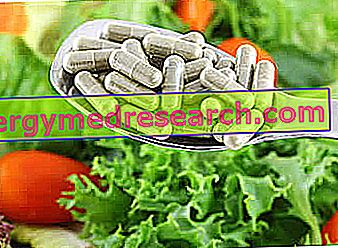Colonoscopy
Colonoscopy is an endoscopic examination aimed at observing the intestinal mucosa of the large intestine and the distal part of the small intestine.

WARNING! To avoid unnecessary alarm, let us remember that an intestinal polyp can take up to 15 years to transform into a cancerous lesion; however, after reaching a certain age (around 55-60 years), colonoscopy should be considered a screening analysis.
In certain subjects considered to be potentially at risk (due to familiarity, clinical history of other injuries, inflammatory bowel suffering, etc.), it would be desirable for it to be systematically programmed and repeated from the age of 40.
Being a visual examination, colonoscopy requires a preparatory phase of colon cleansing, in which the diet plays a very important role (for more information read the article: Diet in preparing for colonoscopy).
On the other hand, not everyone knows what diet to follow immediately after the exam. In the next chapter we will describe the diet best suited to the recovery phase from colonoscopy.
After Colonoscopy: What to Eat?
Restoring bowel regularity after colonoscopy makes the filling time of the digestive tract conditional; in other words, as long as the intestine is not full, evacuations can hardly be regular.
Moreover, it should be kept in mind that, after a colonoscopy, the colon is:
- Almost devoid of intestinal bacterial flora
- Denutrito (like the rest of the body)
- Physiological protective mucus washed.
The fundamental principles to avoid the classic intestinal symptoms (especially constipation, but also diarrhea) are:
- Avoid alcohol and beverages / foods or supplements containing nervine molecules (caffeine, theobromine, teine etc.) for at least 12-24 hours; among these: wine, beer, grappa, coffee, chocolate, cocoa, fermented teas, energy drinks, thermogenic supplements etc.
- Avoid foods that are too fatty and recipes that involve the use of many condiments, including salt and spices (stews, baked roast lardellati, amatriciana pasta, pan-fried spinach with sausage and the like).
- In the event that the colonoscopy has provided for a heavy sedation, or that the subject is particularly affected, it is advisable to structure a liquid or semi-liquid diet; the most suitable foods are peeled and well-cooked fruits, vegetables and legumes (for example, vegetable and / or legume pastas - not blended - and cooked apples - peeled -).
This recommendation is necessary because, in some cases, anesthesia causes nausea and / or vomiting; a clouded mind is not able to better manage this kind of impulses, which is why it would be better to optimize the expulsion process.
- Prefer a diet with low insoluble residue, increasing the intake of soluble fiber. These have a prebiotic action, improve the consistency of the stools and regularize intestinal activity without stressing peristalsis excessively.
- Avoid recipes cooked with systems that tend to produce toxic molecules; avoid even foods that contain nitrates and nitrites. This is a valid criterion also for healthy people, however, considering that the intestine is more vulnerable, it is better to prevent these potentially carcinogenic elements from coming into contact with the mucosa.
To limit nitrates and nitrites it is essential to avoid preserved meat (sausages) and wash the vegetables thoroughly. To limit toxic molecules it is essential to discard the grilling, grilling, spit cooking, frying and cooking in a pan over high heat. Instead, we recommend cooking by boiling, pressing, steaming, vacuum packing and potting.
- Introduce foods gradually, especially those that are poorly tolerated. For example, on the first day consume only: rice, veal, lettuce and extra virgin olive oil, which are part of the most universally tolerated foods.
- Respect the criterion of subjective tolerance, based on the knowledge of one's own organism; for example, knowing that ginger or chili peppers could irritate the intestine causing diarrhea and cramps, postpone their use until total recovery.
- Increase the amount of water and minerals in the diet. Patients undergoing colonoscopy tend to be dehydrated due to diet and visit preparation solutions (tendentially osmotic). By eating first course dishes, the water supply increases significantly and does not conflict with the other recommendations mentioned above. In addition, it is recommended to drink little and often; isotonic beverages of hydro-saline integration may be desirable.
- In the most difficult cases, ie those in which there is an alteration of the alvo (constipation or diarrhea), foods, or supplements or drugs, with probiotic action (with lactobacilli and bifidobacteria), prebiotic and nourishing could be very useful for enterocytes.

Products with a prebiotic action are basically complex and gelatinized carbohydrates (for example, in parboiled rice) and soluble fibers (algae such as glucomannans, vegetables such as inulin and fruits such as pectin). Probiotics and prebiotics contribute to nourishing the cells of the intestine (with the production of butyric acid and polyamines) but, if this is not enough, we recall that some molecules such as lauric acid (coconut oil) and food butyric acid (of butter) can improve the condition of the mucosa.
Diet After Polypectomy
The endoscopic removal of a polyp, also called polypectomy, compromises the eating style in a variable way depending on the size of the polyp and the technique of intervention; obviously, the least problematic case is the endoscopic removal of a polyp less than a centimeter in diameter.
The dietary measures to be taken following polypectomy are the following:
- First 48 hours: liquid diet, without solid food; moreover, it is advisable to structure a nutritional regime based on easily digestible foods, poor in insoluble fibers (legume peel, cereal bran, etc.) and free of spices and stimulants (coffee, cocoa, red or black tea, etc.).
- First 72 hours: avoid alcohol and other irritants by inserting solid foods.
- Over 96 hours: comply with the criteria of the post colonoscopy diet in order to avoid enteroclisms in the most absolute way. In the event of anal blood loss or other symptoms, it is advisable to resume fasting and go to the emergency room for tests.




